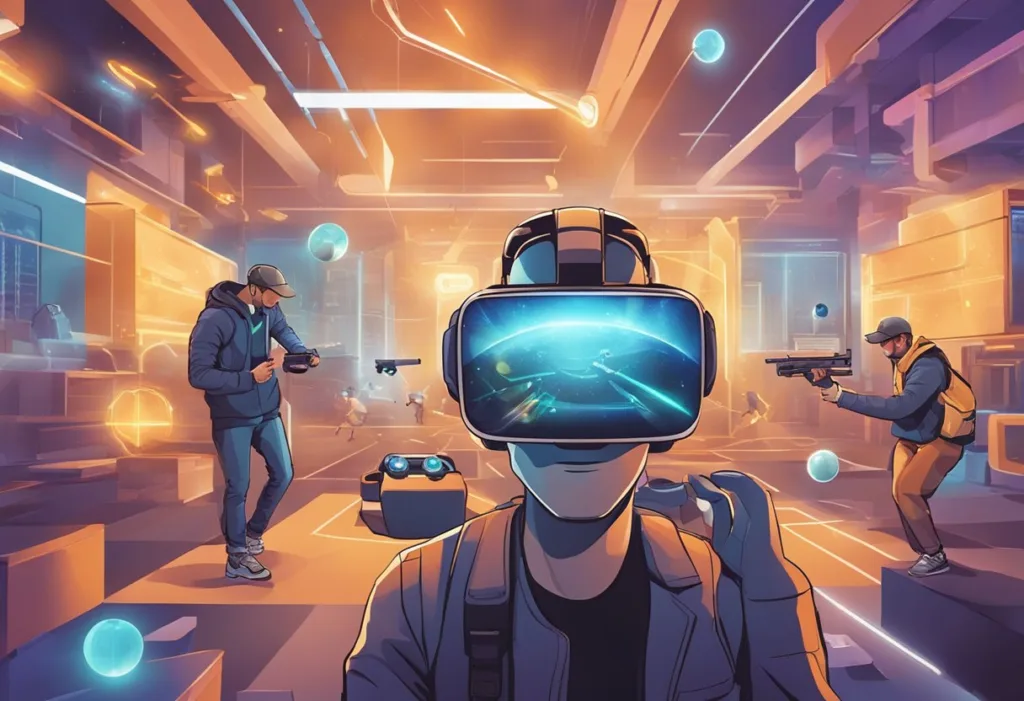Augmented reality (AR) games have become increasingly popular in recent years, providing a unique and immersive gaming experience that blends the real world with virtual elements. Whether you’re a game developer looking to create the next big hit or just someone interested in exploring the exciting world of AR gaming, there are plenty of ideas and concepts to consider. In this blog post, I will share with you 7 Augmented reality game ideas and how to start each of these AR game ideas.
To create an engaging AR game, you must first understand the core concepts of AR gaming, such as the importance of designing an intuitive user interface and creating a seamless user experience. It’s crucial to consider the technological foundations of AR games, including the hardware and software required to create immersive experiences.
Designing an AR game that is both fun and engaging can be a challenging task, but with the right approach and a solid understanding of the fundamentals, you can create an experience that players will love. In this article, we’ll explore some of the most exciting and innovative ideas for AR games and provide insights into the key concepts and best practices for designing successful AR games.
Core Concepts of Augmented Reality Games
Augmented Reality (AR) games are the real-time integration of virtual elements with the physical environment of players. The basic premise of AR gaming involves a combination of real and virtual worlds, real-time interaction, and accurate 3D registration of virtual objects in the real world.
AR games are designed to provide a unique gaming experience that combines the real world with virtual elements. The technology used in AR games is based on computer vision, which allows the device to recognize and track real-world objects. AR games are played using smartphones, tablets, and other mobile devices that have a camera and a screen.
One of the core concepts of AR games is the use of markers. Markers are physical objects that are used to trigger virtual objects in the game. The camera on the device recognizes the marker and overlays the virtual object on top of it. This creates the illusion that the virtual object is part of the real world.
Another core concept of AR games is the use of location-based services. Location-based services use the GPS on the device to track the player’s location and provide a unique gaming experience based on their location. This allows for games that are location-specific and can be played in different parts of the world.
AR games provide a unique gaming experience that combines the real world with virtual elements. The use of markers and location-based services are just a few of the core concepts of AR games. With the advancement of technology, we can expect to see more innovative AR game ideas in the future.
Augmented reality game ideas
- Time-Traveler Tourist
- AR Escape Room
- Mythical Creature Collection
- Historical Battle Reenactments
- Fitness Challenge Trails
- AR Cooking Challenge
- Eco Warrior Adventure
Time-Traveler Tourist
In Time-Traveler Tourist, players are transported to various historical periods through AR, allowing them to explore and interact with different eras in their current surroundings. Imagine walking through your local park and witnessing a colonial-era market or a medieval tournament. Players could complete quests that involve solving puzzles based on historical facts or collecting items from different time periods to progress in the game. This concept not only entertains but also educates players about history in an immersive way, making learning more engaging and memorable.
AR Escape Room
The AR Escape Room game idea brings the thrill of escape room puzzles to any location. Players use their device to uncover clues and solve puzzles that are superimposed onto their environment. Each player’s room or chosen location becomes a unique puzzle to escape from, with a timer to add to the challenge.
The game could include a variety of themes, such as mystery, science fiction, or horror, providing a wide range of immersive experiences. This concept leverages the popularity of escape rooms and the convenience of mobile gaming to create a new form of entertainment that can be enjoyed anywhere.
Mythical Creature Collection
Mythical Creature Collection would allow players to discover and capture fantastical creatures that appear in the world around them. Using AR, players could find creatures like dragons, unicorns, or phoenixes in their own backyard or local park. Each creature could have unique abilities and require different strategies to capture, providing a constant challenge.
Players could train their creatures, battle against others, and even trade with friends. This game would tap into the collectible aspect of gaming, providing a sense of accomplishment and progression as players expand their collection.
Historical Battle Reenactments
Historical Battle Reenactments would let players participate in or witness important battles from history through AR. By visiting specific locations, players could unlock historical battles that took place there and either watch a reenactment or take part in an interactive experience where they can influence the outcome. The game could offer educational content about the battle’s context, key figures, and impact on history. This would provide a powerful way to learn about history by virtually experiencing pivotal moments in time.
Fitness Challenge Trails
Fitness Challenge Trails would integrate AR with physical exercise by setting up virtual obstacle courses or challenge trails in real-world locations. Players could run, jump, and perform other exercises to interact with virtual objects and complete the course. The game could track fitness progress and adapt challenges to the player’s fitness level, making it a fun and personalized way to stay active. This concept promotes health and well-being while offering a gamified exercise experience that is more engaging than traditional workouts.
AR Cooking Challenge
AR Cooking Challenge would bring a new twist to cooking by overlaying AR graphics onto real-world ingredients and kitchen tools. Players could learn new recipes and cooking techniques by following interactive, step-by-step guides that display in their actual kitchen. The game could include challenges such as time limits or ingredient substitutions to test the player’s culinary skills. This concept combines the joy of cooking with the engagement of gaming, creating a unique and educational experience for food enthusiasts.
Eco Warrior Adventure
Eco Warrior Adventure would task players with saving the environment through AR-based missions. Players could clean up virtual pollution in their local area, plant virtual trees, and learn about sustainability and conservation. The game could partner with real-world environmental organizations to translate in-game achievements into actual contributions, such as tree planting initiatives. This concept not only entertains but also raises awareness and encourages players to take action on environmental issues in their community.
Designing Engaging AR Game Experiences

When designing an Augmented Reality game, it’s essential to create an engaging experience that keeps players interested and immersed in the game world. In this section, we’ll explore some key elements to consider when designing an AR game that will keep players engaged and excited.
Narrative and Storytelling
One of the most important elements of an engaging AR game is a compelling narrative and storytelling. A well-crafted story can immerse players in the game world and create an emotional connection with the game’s characters and setting. You can use characters, settings, and plotlines to create a unique and engaging experience that keeps players coming back for more.
To create a compelling narrative, you need to consider the game’s theme, characters, and setting. You can use these elements to build a world that feels immersive and engaging. You can also use dialogue and cutscenes to advance the story and create an emotional connection with players.
Game Mechanics and Dynamics
Game mechanics and dynamics are the core of any game. They are the rules, systems, and interactions that players engage with to progress through the game. When designing an AR game, it’s essential to create mechanics and dynamics that are engaging and fun.
One way to create engaging mechanics is to provide players with a sense of progression and achievement. You can do this by creating a leveling system or by providing players with rewards for completing tasks. You can also create mechanics that require players to use their physical environment to progress through the game, creating a unique and immersive experience.
Visual and Audio Elements
Visual and audio elements are critical to creating an immersive and engaging AR game experience. You can use visual elements like 3D models, textures, and lighting to create a realistic and immersive game world. You can also use audio elements like music and sound effects to create an emotional connection with players and enhance the game’s atmosphere.
When designing the visual and audio elements of your game, you need to consider the game’s theme and setting. You can use visual and audio elements to create a unique and immersive experience that is tailored to the game’s world and story.
Designing an engaging AR game experience requires careful consideration of narrative and storytelling, game mechanics and dynamics, and visual and audio elements. By creating a game that is immersive, engaging, and fun, you can create an experience that keeps players coming back for more.
Technological Foundations for AR Games

When it comes to developing AR games, there are a few technological foundations that you need to understand. These include AR platforms and tools, location-based services, and computer vision and object recognition.
AR Platforms and Tools
AR platforms and tools are essential for building AR games. Unity, Unreal Engine, and Vuforia are some of the most popular platforms used for AR game development. Unity is a cross-platform game engine that supports AR development for both iOS and Android devices. Vuforia is a popular AR development platform that provides a range of features, including image recognition, object recognition, and tracking.
Location-Based Services
Location-based services are another important technological foundation for AR games. These services allow you to create games that are location-aware, meaning that they can detect the user’s location and provide relevant information based on that location. This can be used to create games that are based on real-world locations, such as scavenger hunts or geocaching games.
Computer Vision and Object Recognition
Computer vision and object recognition are also critical for building AR games. These technologies allow the game to recognize and track objects in the real world, which can be used to create interactive experiences. For example, a game might use computer vision to track a user’s hand movements and use that information to control the game.
Understanding the technological foundations of AR games is essential for creating engaging and immersive experiences. By using AR platforms and tools, location-based services, and computer vision and object recognition, you can create games that are both fun and interactive.
User Interaction and Interface Design

When designing an augmented reality game, user interaction and interface design are critical components to consider. The success of the game depends on how intuitive and engaging the user interface is. Here are two critical aspects of user interaction and interface design that you should keep in mind:
Gesture and Voice Controls
Gesture and voice controls are essential elements of augmented reality games. They allow players to interact with the game world in a more natural and intuitive way. Gesture controls involve using hand movements or body gestures to control the game, while voice controls allow players to use their voice to interact with the game.
When designing gesture and voice controls, it is essential to keep them simple and easy to use. Players should be able to learn and use them quickly without being overwhelmed. It is vital to provide visual and audio feedback to let players know when their actions have been registered.
HUD and Immersive Interfaces
The heads-up display (HUD) is an essential element of augmented reality games. It provides players with critical information such as health, ammo, and other game-related stats. The HUD should be designed to be unobtrusive and not distract from the game world.
Immersive interfaces are another critical aspect of augmented reality games. They allow players to interact with the game world in a more natural and intuitive way. Immersive interfaces involve using virtual objects and environments to create a more immersive experience for the player.
When designing HUD and immersive interfaces, it is important to keep them simple and easy to use. Players should be able to access critical information quickly without being overwhelmed. It is vital to provide visual and audio feedback to let players know when their actions have been registered.
Multiplayer and Social Features
Augmented reality games can offer a unique and engaging multiplayer experience that traditional games cannot match. By leveraging the capabilities of AR technology, developers can create immersive and interactive games that allow players to compete or collaborate with each other in real-time.
Competitive and Cooperative Modes
One way to incorporate multiplayer features into AR games is by offering competitive or cooperative modes. In competitive modes, players can challenge each other to complete tasks or achieve objectives, with the winner being the first to complete the challenge. In cooperative modes, players can work together to solve puzzles or defeat enemies, with each player contributing their unique skills and abilities to the team.
Social Integration and Sharing
Another way to enhance the multiplayer experience in AR games is by integrating social features and sharing capabilities. Players can connect with each other through social media platforms or in-game chat systems, allowing them to communicate and coordinate their efforts. Players can share their progress and achievements with friends and followers, creating a sense of community and engagement around the game.
To make the most of these social features, developers can incorporate leaderboards, achievements, and challenges that encourage players to compete and collaborate with each other. By creating a dynamic and engaging multiplayer experience, AR games can offer a unique and exciting way to connect with others and explore new worlds.
Monetization Strategies in AR Gaming
When it comes to monetizing augmented reality games, there are several strategies that you can use to generate revenue. In this section, we will discuss two of the most popular monetization strategies in AR gaming: in-app purchases and advertising/sponsorships.
In-App Purchases
One of the most common ways to monetize an AR game is through in-app purchases. In-app purchases allow players to buy virtual goods or currency within the game, which can be used to enhance their gameplay experience. For example, players may be able to purchase new weapons or power-ups that give them an advantage over other players.
To make the most of in-app purchases, it is important to offer a variety of options that appeal to different types of players. Some players may be willing to spend a lot of money on virtual goods, while others may only be interested in making small purchases. By offering a range of options, you can cater to different players and maximize your revenue.
Advertising and Sponsorships
Another popular way to monetize an AR game is through advertising and sponsorships. This can include in-game ads, sponsored content, and product placement. For example, a game developer may partner with a company to feature their products within the game, or they may display ads for other products or services.
To make the most of advertising and sponsorships, it is important to balance revenue generation with player experience. Too many ads can be intrusive and annoying, which can turn players off and hurt your revenue in the long run. By finding the right balance between ads and gameplay, you can create a revenue stream that is sustainable and enjoyable for players.
There are several effective strategies for monetizing augmented reality games. By utilizing in-app purchases and advertising/sponsorships, you can generate revenue while providing an enjoyable gameplay experience for your players.
Challenges and Limitations of AR Gaming
Hardware Constraints
AR gaming is a relatively new technology that requires advanced hardware to work smoothly. One of the biggest challenges of AR gaming is the hardware constraints. AR technology requires significant processing power and advanced sensors to accurately track and place digital objects in the real world. This means that not all devices can support AR gaming, and those that can may experience performance issues.
AR gaming requires high-quality cameras and displays to create an immersive experience. This can be a challenge for developers who need to optimize their games for a wide range of devices with different hardware specifications.
Privacy and Security Concerns
Another challenge of AR gaming is privacy and security concerns. AR games often require access to a user’s camera, microphone, and location data, which can raise privacy concerns. Developers must ensure that their games are designed with user privacy in mind and that they adhere to data protection regulations.
Moreover, AR gaming can also pose security risks. Hackers can potentially exploit vulnerabilities in AR games to gain access to user data or to spread malware. Developers must take steps to secure their games and protect their users’ data.
To overcome these challenges, developers must work closely with hardware manufacturers and security experts to ensure that their games are optimized for performance and security. They must also be transparent about their data collection practices and provide users with options to control their privacy settings.
Frequently Asked Questions
What are the key elements to consider when designing an augmented reality game for mobile platforms?
When designing an augmented reality game for mobile platforms, it is important to consider the technical limitations of the device, the game mechanics, and the user experience. The game should be designed to work seamlessly with the device’s camera and sensors. The game mechanics should be easy to understand and should not require too much physical movement. The user experience should be intuitive and engaging, with clear instructions and feedback.
How can augmented reality games be effectively monetized?
There are several ways to monetize augmented reality games, including in-app purchases, advertising, and sponsorships. In-app purchases can be used to sell virtual items, power-ups, and other game enhancements. Advertising can be used to display ads during gameplay or in between levels. Sponsorships can be used to promote real-world products or services within the game.
What are some innovative mechanics unique to augmented reality games?
Augmented reality games can incorporate a variety of innovative mechanics, such as location-based gameplay, gesture recognition, and object recognition. Location-based gameplay allows the game to respond to the player’s physical location in the real world. Gesture recognition allows the game to respond to the player’s hand movements, while object recognition allows the game to recognize and interact with real-world objects.
How can developers ensure a user-friendly interface in AR games for beginners?
Developers can ensure a user-friendly interface in AR games for beginners by providing clear instructions and feedback, using intuitive controls, and gradually introducing new game mechanics. The game should be designed to be easy to understand and should not require too much physical movement. The user interface should be clean and uncluttered, with clear labeling and easy-to-read text.
What are the current trends in augmented reality gaming for adults?
Some current trends in augmented reality gaming for adults include location-based gaming, social gaming, and immersive experiences. Location-based gaming allows players to explore the real world and interact with real-world objects and locations. Social gaming allows players to connect with friends and compete against each other. Immersive experiences provide a fully immersive and interactive game world, often using virtual reality technology.
Can you provide case studies of successful augmented reality games launched in recent years?
Some successful augmented reality games launched in recent years include Pokemon Go, Ingress, and Jurassic World Alive. Pokemon Go and Ingress both use location-based gameplay, while Jurassic World Alive uses object recognition to allow players to collect virtual dinosaurs. These games have all been successful due to their engaging gameplay, intuitive user interface, and innovative use of augmented reality technology.














